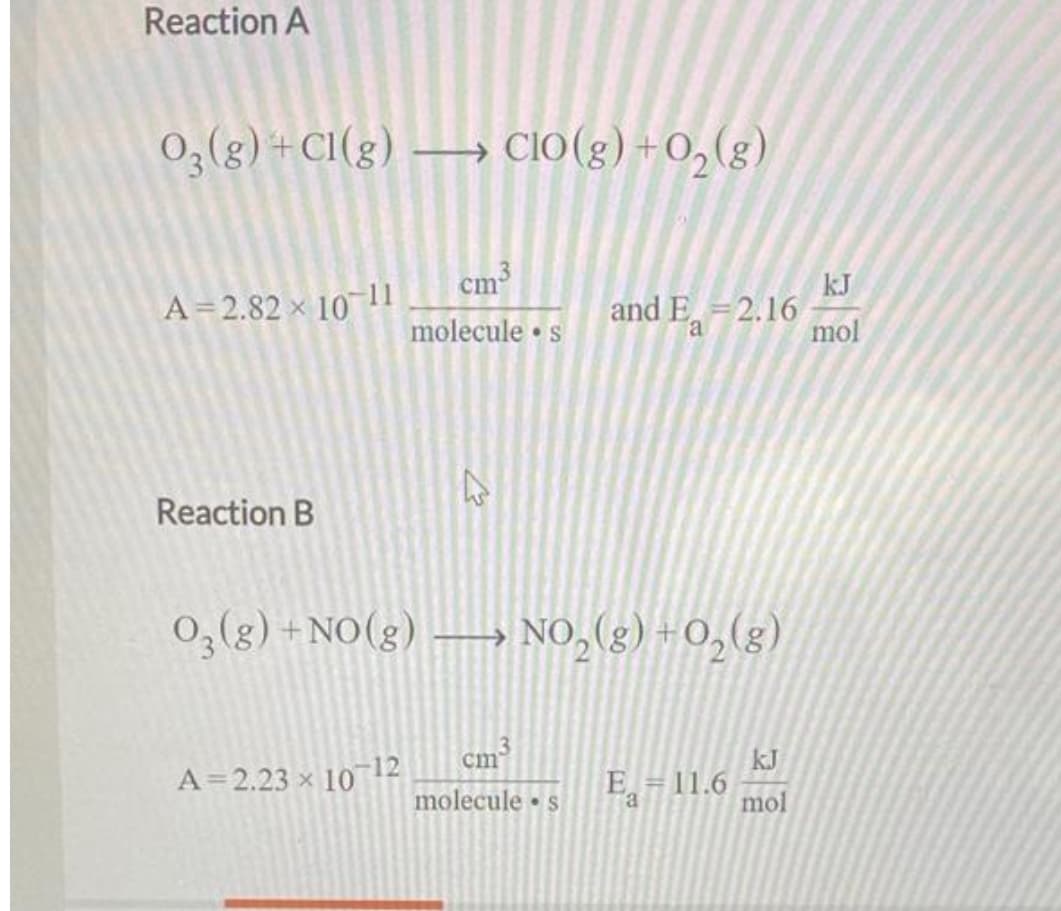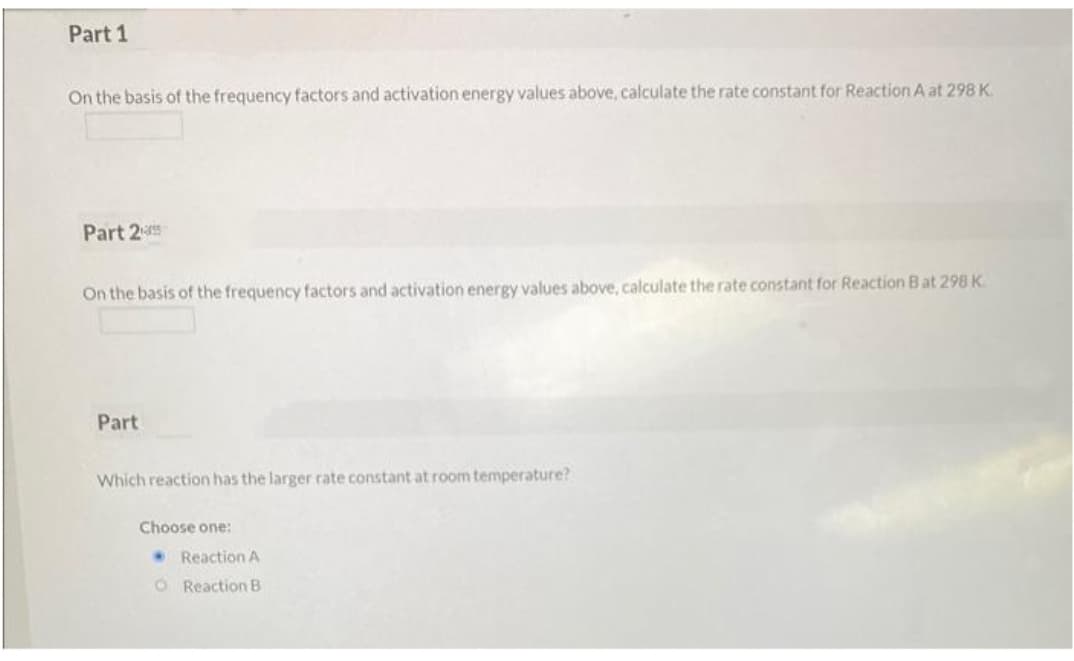Part 1 On the basis of the frequency factors and activation energy values above, calculate the rate constant for Reaction A at 298 K. Part 2 On the basis of the frequency factors and activation energy values above, calculate the rate constant for Reaction B at 298 K Part Which reaction has the larger rate constant at room temperature? Choose one: • Reaction A O Reaction B
Part 1 On the basis of the frequency factors and activation energy values above, calculate the rate constant for Reaction A at 298 K. Part 2 On the basis of the frequency factors and activation energy values above, calculate the rate constant for Reaction B at 298 K Part Which reaction has the larger rate constant at room temperature? Choose one: • Reaction A O Reaction B
Chemistry by OpenStax (2015-05-04)
1st Edition
ISBN:9781938168390
Author:Klaus Theopold, Richard H Langley, Paul Flowers, William R. Robinson, Mark Blaser
Publisher:Klaus Theopold, Richard H Langley, Paul Flowers, William R. Robinson, Mark Blaser
Chapter12: Kinetics
Section: Chapter Questions
Problem 51E: Chemical reactions occur when reactants collide. What are two factors that may prevent a collision...
Related questions
Question

Transcribed Image Text:Reaction A
03(g) + Cl(g) →→→ CIO(g) + O₂(g)
A=2.82 × 10 11
Reaction B
A=2.23 × 10-12
3
cm
molecule s
کے
O₂(g) + NO(g) →→→ NO₂(g) + O₂(g)
3
and Ea
cm
molecule s
-2.16
E₂11.6
kJ
mol
kJ
mol

Transcribed Image Text:Part 1
On the basis of the frequency factors and activation energy values above, calculate the rate constant for Reaction A at 298 K.
Part 2
On the basis of the frequency factors and activation energy values above, calculate the rate constant for Reaction Bat 298 K
Part
Which reaction has the larger rate constant at room temperature?
Choose one:
• Reaction A
O Reaction B
Expert Solution
This question has been solved!
Explore an expertly crafted, step-by-step solution for a thorough understanding of key concepts.
This is a popular solution!
Trending now
This is a popular solution!
Step by step
Solved in 3 steps with 3 images

Knowledge Booster
Learn more about
Need a deep-dive on the concept behind this application? Look no further. Learn more about this topic, chemistry and related others by exploring similar questions and additional content below.Recommended textbooks for you

Chemistry by OpenStax (2015-05-04)
Chemistry
ISBN:
9781938168390
Author:
Klaus Theopold, Richard H Langley, Paul Flowers, William R. Robinson, Mark Blaser
Publisher:
OpenStax

Introductory Chemistry: A Foundation
Chemistry
ISBN:
9781337399425
Author:
Steven S. Zumdahl, Donald J. DeCoste
Publisher:
Cengage Learning

Chemistry: Matter and Change
Chemistry
ISBN:
9780078746376
Author:
Dinah Zike, Laurel Dingrando, Nicholas Hainen, Cheryl Wistrom
Publisher:
Glencoe/McGraw-Hill School Pub Co

Chemistry by OpenStax (2015-05-04)
Chemistry
ISBN:
9781938168390
Author:
Klaus Theopold, Richard H Langley, Paul Flowers, William R. Robinson, Mark Blaser
Publisher:
OpenStax

Introductory Chemistry: A Foundation
Chemistry
ISBN:
9781337399425
Author:
Steven S. Zumdahl, Donald J. DeCoste
Publisher:
Cengage Learning

Chemistry: Matter and Change
Chemistry
ISBN:
9780078746376
Author:
Dinah Zike, Laurel Dingrando, Nicholas Hainen, Cheryl Wistrom
Publisher:
Glencoe/McGraw-Hill School Pub Co

Physical Chemistry
Chemistry
ISBN:
9781133958437
Author:
Ball, David W. (david Warren), BAER, Tomas
Publisher:
Wadsworth Cengage Learning,

Introduction to General, Organic and Biochemistry
Chemistry
ISBN:
9781285869759
Author:
Frederick A. Bettelheim, William H. Brown, Mary K. Campbell, Shawn O. Farrell, Omar Torres
Publisher:
Cengage Learning

Chemistry & Chemical Reactivity
Chemistry
ISBN:
9781337399074
Author:
John C. Kotz, Paul M. Treichel, John Townsend, David Treichel
Publisher:
Cengage Learning